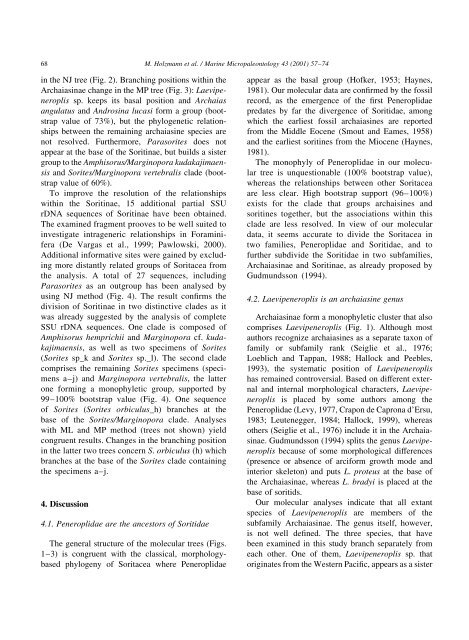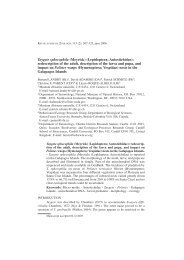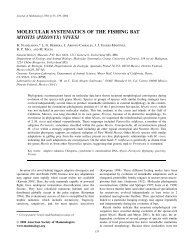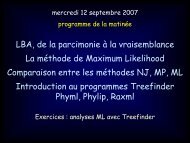Molecular phylogeny of large miliolid foraminifera - University of ...
Molecular phylogeny of large miliolid foraminifera - University of ...
Molecular phylogeny of large miliolid foraminifera - University of ...
You also want an ePaper? Increase the reach of your titles
YUMPU automatically turns print PDFs into web optimized ePapers that Google loves.
68M. Holzmann et al. / Marine Micropaleontology 43 2001) 57±74in the NJtree Fig. 2). Branching positions within theArchaiasinae change in the MP tree Fig. 3): Laevipeneroplissp. keeps its basal position and Archaiasangulatus and Androsina lucasi form a group bootstrapvalue <strong>of</strong> 73%), but the phylogenetic relationshipsbetween the remaining archaiasine species arenot resolved. Furthermore, Parasorites does notappear at the base <strong>of</strong> the Soritinae, but builds a sistergroup to the Amphisorus/Marginopora kudakajimaensisand Sorites/Marginopora vertebralis clade bootstrapvalue <strong>of</strong> 60%).To improve the resolution <strong>of</strong> the relationshipswithin the Soritinae, 15 additional partial SSUrDNA sequences <strong>of</strong> Soritinae have been obtained.The examined fragment prooves to be well suited toinvestigate intrageneric relationships in ForaminiferaDe Vargas et al., 1999; Pawlowski, 2000).Additional informative sites were gained by excludingmore distantly related groups <strong>of</strong> Soritacea fromthe analysis. A total <strong>of</strong> 27 sequences, includingParasorites as an outgroup has been analysed byusing NJmethod Fig. 4). The result con®rms thedivision <strong>of</strong> Soritinae in two distinctive clades as itwas already suggested by the analysis <strong>of</strong> completeSSU rDNA sequences. One clade is composed <strong>of</strong>Amphisorus hemprichii and Marginopora cf. kudakajimaensis,as well as two specimens <strong>of</strong> SoritesSorites sp_k and Sorites sp._l). The second cladecomprises the remaining Sorites specimens specimensa±j) and Marginopora vertebralis, the latterone forming a monophyletic group, supported by99±100% bootstrap value Fig. 4). One sequence<strong>of</strong> Sorites Sorites orbiculus_h) branches at thebase <strong>of</strong> the Sorites/Marginopora clade. Analyseswith ML and MP method trees not shown) yieldcongruent results. Changes in the branching positionin the latter two trees concern S. orbiculus h) whichbranches at the base <strong>of</strong> the Sorites clade containingthe specimens a±j.4. Discussion4.1. Peneroplidae are the ancestors <strong>of</strong> SoritidaeThe general structure <strong>of</strong> the molecular trees Figs.1±3) is congruent with the classical, morphologybased<strong>phylogeny</strong> <strong>of</strong> Soritacea where Peneroplidaeappear as the basal group H<strong>of</strong>ker, 1953; Haynes,1981). Our molecular data are con®rmed by the fossilrecord, as the emergence <strong>of</strong> the ®rst Peneroplidaepredates by far the divergence <strong>of</strong> Soritidae, amongwhich the earliest fossil archaiasines are reportedfrom the Middle Eocene Smout and Eames, 1958)and the earliest soritines from the Miocene Haynes,1981).The monophyly <strong>of</strong> Peneroplidae in our moleculartree is unquestionable 100% bootstrap value),whereas the relationships between other Soritaceaare less clear. High bootstrap support 96±100%)exists for the clade that groups archaisines andsoritines together, but the associations within thisclade are less resolved. In view <strong>of</strong> our moleculardata, it seems accurate to divide the Soritacea intwo families, Peneroplidae and Soritidae, and t<strong>of</strong>urther subdivide the Soritidae in two subfamilies,Archaiasinae and Soritinae, as already proposed byGudmundsson 1994).4.2. Laevipeneroplis is an archaiasine genusArchaiasinae form a monophyletic cluster that alsocomprises Laevipeneroplis Fig. 1). Although mostauthors recognize archaiasines as a separate taxon <strong>of</strong>family or subfamily rank Seiglie et al., 1976;Loeblich and Tappan, 1988; Hallock and Peebles,1993), the systematic position <strong>of</strong> Laevipeneroplishas remained controversial. Based on different externaland internal morphological characters, Laevipeneroplisis placed by some authors among thePeneroplidae Levy, 1977, Crapon de Caprona d'Ersu,1983; Leutenegger, 1984; Hallock, 1999), whereasothers Seiglie et al., 1976) include it in the Archaiasinae.Gudmundsson 1994) splits the genus Laevipeneroplisbecause <strong>of</strong> some morphological differencespresence or absence <strong>of</strong> arciform growth mode andinterior skeleton) and puts L. proteus at the base <strong>of</strong>the Archaiasinae, whereas L. bradyi is placed at thebase <strong>of</strong> soritids.Our molecular analyses indicate that all extantspecies <strong>of</strong> Laevipeneroplis are members <strong>of</strong> thesubfamily Archaiasinae. The genus itself, however,is not well de®ned. The three species, that havebeen examined in this study branch separately fromeach other. One <strong>of</strong> them, Laevipeneroplis sp. thatoriginates from the Western Paci®c, appears as a sister






